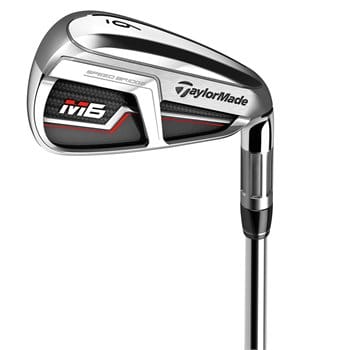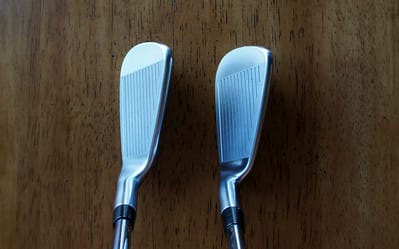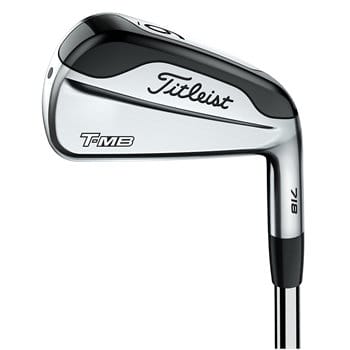The cavity back vs. muscle back debate has been a strong one for many years. Better players will tell you that there is nothing like a muscle back, and other golfers argue there is no reason to make the game harder than it needs to be, and the cavity back iron works just fine.
In my golf career, I have had both cavity back and muscle back irons, and I can tell you that they both have some great positives that should be considered. In the end, the most important thing to do is to pick a golf iron that fits the needs of your game, not one that wins the best golf iron awards each year.
We have tested and reviewed many cavity back and muscle back irons, and these are the main differences and some helpful hints to have you choose the best golf irons for your game.
Also Read: Best Cavity Back Irons in 2024
Features of the Cavity Back

Cavity back irons are often called game improvement golf irons. Cavity back irons make the game of golf considerably more manageable as they offer both distance and forgiveness to an average player. Even if you miss the center of the cavity back iron slightly, the end result will be quite good. If you think cavity back irons are a good choice for your game, here are the things to know:
Larger Club Head
The cavity back has a slightly larger clubhead than other golf irons on the market. This more oversized clubhead gives more room for a sweet spot and, therefore, leads to more forgiveness. With a larger clubhead, many golfers will also have greater confidence in their ability to hit the ball up in the air with plenty of distance.
Thicker Top Line
From the top down, the cavity back has a much thicker look. Since this club is not made from a single piece of metal, the construction looks a bit different and can sometimes be a difficult thing for the more experienced player to get used to.
Overall a thicker top line typically means that the clubhead of the iron is filled with some type of golf performance material. Even though the face of the cavity back iron may be thinner, the inside of the clubhead being hollow is a great way to ensure that the jump from the clubface is a good one.
Increased Forgiveness

Cavity back irons have lots of forgiveness. The center of gravity and weight in the club head is moved around to ensure extra forgiveness and make it easier for golfers of any ability. This is why so many higher handicap players like the cavity back irons.
However, plenty of lower handicap golfers are starting to put the cavity back golf irons in their bag to help improve overall scoring in the long irons.
Also Read: Most Forgiving Irons in 2024
Less Expensive Construction
The cavity back irons can be produced quickly, and they are typically not as expensive as the muscle back. The muscle back irons require a bit more attention to detail and precision because of their manufacturing process.
Of course, golf club pricing has increased considerably through the years, and a set of brand new cavity back irons will probably still be between $800 and $1000. However, the muscle back typically starts well over $1000.
Multi-Material Construction
For many years, the multi-material construction of the cavity back iron may not have been looked at as quite as much of a positive. However, at this point, it is. There have been so many discoveries in the game of golf that have led us to realize that tungsten, carbon, titanium, and other materials can all work together to make a really great golf club.
By combining several materials, you can get the best of speed technology, distance technology, and forgiveness built into one impressive golf club. There is no reason not to have everything you want in a golf club when you can have it all.
Pros & Cons of cavity back
PROS
- Very forgiving: a cavity back iron is more forgiving and will give golfers a bit of room to miss the center of the clubface.
- Affordable and easy to customize: the cavity back irons are easy to customize, offered in many different versions, and even have oversize options for golfers.
- Higher launching: the average cavity back iron has a low center of gravity; this center of gravity greatly increases the ball flight a player can get with their irons.
- It can be made with many different materials: cavity back irons are starting to include more and more tungsten materials to improve overall feel and performance.
CONS
- Less workability: cavity back irons are not all that workable, meaning you will have a hard time hitting a fade or a draw even when you try to do so.
- Hard to control ball flight: keeping the ball flight low on a very forgiving cavity back iron can be a bit difficult.
- Thicker and bulkier look: the cavity back irons are bulky and can have a thick top-down look.
Also Read: Best Muscle Back Irons in 2024
Features of the Muscle Back

Muscle back golf clubs allow the best players in the game to hit the ball as close to the hole as possible. Some golfers will call muscle back irons blades, and this is generally accepted. However, some golf manufacturers will offer both a proper muscle back and a true blade as part of their product lineup.
The great thing about muscle back irons is that they don’t advertise themselves as being overly forgiving or easy golf clubs to play. Essentially you will earn your right to play these muscle back irons by having the game to do so.
Thin Top Line
My favorite part of the muscle back irons is the look. There is nothing purer looking than a muscle back iron, and although you can’t make all of your playing decisions based on the look of a club, it certainly helps that these are some of the better looking golf clubs in the game.
From the top down, expect a clean and thin line that will bring the better player a bit more confidence. If you have never been able to draw the ball or to control the ball flight, the muscle back iron gives you full control!
Smaller Blade Length
The smaller blade length of the muscle back irons means that they are going to look smaller than a cavity back golf irons. This is not just the top-down look but the overall length of the golf iron club head. With a smaller blade length, there is a bit less room for a sweet spot.
If your sweet spot is smaller, expect golf shots that could lack a bit of distance and potentially have a greater dispersion.
Workable and Precise
The muscle back irons are much more precise than the cavity back iron. This is an exacting club. It demands accuracy on your part, but in return, you will get a very impressive result. In all my years playing golf, I’ve gone back and forth between cavity backs and muscle back irons a few times.
When I have a muscle back iron in my hand, I feel as though I can get it to do whatever I need it to do. The problem, of course, is that this is fully on me to pull this shot off. My miss is going to be well short, or to the side, if I ever so slightly miss the center of the club head.
Pure Feel with Little Vibration

The pure feel of the muscle back iron is very hard to beat. Golfers that care about feel and the way the ball comes off the clubface the muscle back is for you. In fact, so many players are now able to see the difference in feel that these clubs offer they will purchase combo sets with muscle back irons in the short irons.
As you move up through to the long irons, the cavity backs come back into play because of the forgiveness and extra distance that they can offer golfers.
Pros & Cons of Muscle Back:
PROS
- Great feel: the muscle back has very little vibration at impact and an impressive overall feel.
- Impressive top-down look: the club has a thin and workable look that will increase confidence for the better player.
- Scoring club: With a muscle back in your hands, you can go right at the pin and hit a variety of golf shots that work to get you close to the hole.
CONS
- Difficult to hit: with a small sweet spot, expect to struggle at times with getting the ball up in the air or out of a difficult lie.
- Can be more expensive: Muscle back irons take a bit more time to produce, use different materials, and ultimately cost more money.
- Distance capability is often not as strong: Many muscle back irons are traditionally lofted, so they won’t fly quite as far.
Cavity Back vs. Muscle Back – Comparison Table
| Parameter | Cavity Back | Muscle Back |
|---|---|---|
| Forgiveness | High | Low to Medium |
| Ball Flight | Mid to High | Low to Mid |
| Handicap | Mid to High | Mid to Low |
| Distance | Long | Average |
| Accuracy | Average | High |
| Workability | Average | The Best |
| Feel | Average | The Best |
| Pricing | Average | High |
| Availability | Easily Available | More Limited |
| Longevity | Long Lasting | Long Lasting |
The cavity back and muscle back irons have some similarities, but they also offer different performances. Depending on what you are looking for out of your golf clubs, you will have to consider whether the cavity back or the muscle back is the better choice.
The main differences you will see are when it comes to workability and the ability of a player to control their golf shot. The muscle back irons give golfers much more control over their actions; cavity back irons give you forgiveness.
In addition, the muscle back irons require a precise center of the clubhead hit that the cavity back irons do not need. This is why so many mid to high handicappers enjoy the cavity back while the lower handicap golfers like the muscle back.
The lines between cavity back and muscle back are getting more blurred, so finding one that is right for you could be a bit easier than ever before.
Which One Should I Choose?
Golfers should analyze their golf swing consistency and desire for forgiveness and distance before choosing any golf iron. If you are a player ready to try and shoot laser-type shots at the pin, then the muscle back club is for you.
Instead, if you are still working on getting the golf ball up in the air, don’t be worried about the muscle back workability; instead, stick with the cavity back iron. Going for a club fitting can also be a good way to help decide what you need from your golf clubs.
Also Read: Blades Vs. Cavity Back
Conclusion
We hope you now understand the difference between cavity back and muscle back golf irons. Each of these golf irons has something great to offer; it’s just a matter of finding the right fit for your game. Although we like the feel of muscle back, some new cavity back irons have been released to the market with tremendous feel and performance. Try to test out a few clubs, and then take a hard look at your game and its capabilities and make your decision based on that.

